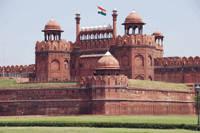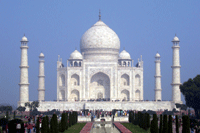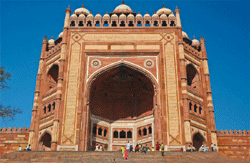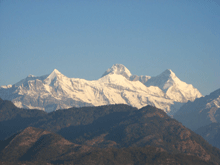Currently only 27 cultural and natural sites in india have been designated unesco world heritage sites. applications for an additional 19 locations to be so declared are pending. in the first of a three-article series, Srinidhi Raghavendra overviews world heritage sites of north india
A nation’s cultural and natural heritage embodied in buildings, monuments and natural wonders is proof of a nation or civilization’s history. Moreover unique buildings and monumented wealth of countries trace the progress of humankind irrespective of where they are located. Therefore with jet travel having made the world’s greatest civilizational and natural wonders accessible to a progressively larger number of students, scholars and lay people around the world, there’s growing awareness of the need to preserve and maintain heritage sites and monuments.
In 1965, the United States of America called for creation of a World Heritage Trust which would promote interna-tional cooperation to protect “the world’s superb natural and scenic areas and historic sites for the present and the future of the entire world citizenry”. The idea was accepted by nature preservation organisations and in 1968 the International Union for Conservation of Nature drafted similar proposals which were presented at the United Nations Conference on Human Environment in Stockholm in 1972. The UN General Assembly referred the idea to the United Nations Educational, Scientific and Cultural Organisation (Unesco) and that very year Unesco drafted an international treaty under the name and style of Convention Concerning Protection of the World Cultural and Natural Heritage. The prime objective of the treaty is to encourage the identification, protection and preservation of cultural and natural heritage sites around the world believed to be of outstanding value to humanity.
Since then Unesco has been inspecting and identifying cultural and natural heritage sites worldwide and designating them Unesco World Heritage Sites (WHS). These sites can be a forest, mountain, lake, desert, monument, building, complex, or city. A list of such sites has been created, and is regularly updated by the International World Heritage Programme administered by the Unesco World Heritage Comm-ittee comprising representatives of 21 member countries of the Unesco Convention. India was a member of the Unesco World Heritage Committee from 2001-07.
The committee is responsible for the implementation of the World Heritage Convention and allocation of grants from a World Heritage Fund for restoration, protection and preservation of world heritage sites. During its term in office, the committee makes final decisions on the inscription or deletion of properties on the World Heritage list.
Currently there are 851 sites (660 cultural, 166 natural, and 25 mixed properties) spread across 141 countries worldwide on the World Heritage list, with Italy leading the scroll (41).
One of the most important benefits of getting listed is access to annual financial grants from the World Heritage Fund, which has a budget of $4 million (Rs.16 crore) per year. Another intangible benefit of inclusion is development of global awareness of the chosen site and its outstanding values.
India’s World Heritage Sites
Widely acknowledged as one of the oldest civilizations in the world, India has a rich cultural and natural heritage. But unfortunately due to centuries of neglect many of these sites have fallen into ruin and require extensive restoration work before they can be included in the World Heritage list. Currently only 27 (22 cultural and five natural) sites in India have qualified for the standards of the UN World Heritage Convention. Applications for including an additional 19 sites are pending with the new Unesco World Heritage Committee.
For ease of presentation and reading convenience, I have categorised India’s world heritage sites geographically and this essay, the first of a three-article series, provides brief overviews of nine World Heritage Sites located in north India. The sites include: Agra Fort, Taj Mahal, Fatehpur Sikri, and Keoladeo National Park in Uttar Pradesh; Nanda Devi and Valley of Flowers National Parks in Uttarakhand; Humayun’s Tomb, Qutb Minar and its monuments and the Red Fort in Delhi and the Mahabodhi Temple Complex at Bodh Gaya, Bihar.
Humayun’s Tomb, Delhi
.gif) Set in fragrant gardens, this strikingly beautiful monument, built in memory of Moghul Emperor Humayun was accorded World Heritage Site status in the cultural category in 1993. The mausoleum is of particular cultural significance as it was the first garden-tomb of the Indian subcontinent and inspired several architectural innova-tions, culminating in the Taj Mahal.
Set in fragrant gardens, this strikingly beautiful monument, built in memory of Moghul Emperor Humayun was accorded World Heritage Site status in the cultural category in 1993. The mausoleum is of particular cultural significance as it was the first garden-tomb of the Indian subcontinent and inspired several architectural innova-tions, culminating in the Taj Mahal.
Sited in the heart of Delhi, Humayun’s tomb is an imposing red sandstone structure surrounded by manicured lawns and tree lined walk-ways. According to history, Humayun’s widow Hamida Banu Begum ordered a fitting resting place for the emperor and construction of this massive necropolis started in 1562 and was completed in eight years. Encircled by fort-like walls, the tomb is crowned by a large main dome and four smaller ones in each corner, built of white marble inlaid with red sandstone to give it a decorative touch. The enormity of the walls and serene emptiness of the tomb envelop and impress the visitor even today.
After the decline of Moghul rule in Delhi, the tomb lay neglected until the early 21st century when the Aga Khan Trust for Culture stepped forward to restore the complex. The restoration work which was completed in March 2003 has reinstated water flow through the watercourses and revitalised the gardens, and the monument has regained much of its original grandeur.
Qutb Complex, Delhi
 The Qutb complex sited in the now fashionable Mehrauli area of South Delhi was accorded World Heritage status in 1993. An array of monuments and buildings surround the Qutb Minar, the tallest brick minaret in the world. The construction of this sprawling complex began in 1199 AD during the reign of Qutb-ud-din Aibak, the founder and first ruler of the Slave Dynasty and was completed by his successor Iltutmish in 1236 AD. New structures were built on the site by several subsequent rulers, including Alauddin Khilji as well as the British.
The Qutb complex sited in the now fashionable Mehrauli area of South Delhi was accorded World Heritage status in 1993. An array of monuments and buildings surround the Qutb Minar, the tallest brick minaret in the world. The construction of this sprawling complex began in 1199 AD during the reign of Qutb-ud-din Aibak, the founder and first ruler of the Slave Dynasty and was completed by his successor Iltutmish in 1236 AD. New structures were built on the site by several subsequent rulers, including Alauddin Khilji as well as the British.
The Qutb Minar, the most famous edifice in the complex, is a 239 ft tall five-storey tower, built of red and white sandstone tapering to a top-floor diameter of 9.18 ft from a 48.6 metre base. In its structure and proportions, it sums up the equilibrium and serenity of Islamic architecture. Each storey is marked by a projecting balcony and is accessible by a 367-step winding staircase up to the third storey. But public access to the third storey of the tower has been prohibited following a stampede in 1981 which led to the tragic deaths of several visiting school children.
Other historical sites in the Qutb vicinity are the Quwwat-ul-Islam mosque, the Ala-I-Darwaza, the Alai Minar and the iron pillar. Conceived and built by Qutb-ud-din Aibak, Quwwat-ul-Islam was the first mosque built in Delhi and is the best surviving example of Slave architecture. One of the world’s great metallurgical wonders, the iron pillar which rises to a height of 7 metres and weighs over six tonnes, was erected by Chandragupta II (375-414 AD) in Udayagiri in central India and shifted to Delhi by Iltutmish.
Red Fort
Popularly known as Lal Qilah, the Red Fort has been recently conferred World Heritage status (2007). Sited in old Delhi, the fort has several firsts to its credit. It is the most popular tourist destination in India’s capital city attracting scores of visitors daily. It is the largest monument in old Delhi and from its historic ramparts, the ex officio prime minister of India addresses the nation on Independence Day (August 15) every year.
 Sited on the right bank of the river Yamuna, the fort is surrounded by a 2.5 km wall which varies in height from 60 ft on the river side to 110 ft towards the city. It displays a fine fusion of Persian, European and Indian art, later designated the Shahjahani style. Construction of the fort began in 1638 AD under the close supervision of Moghul Emperor Shah Jahan and was completed in 1648.
Sited on the right bank of the river Yamuna, the fort is surrounded by a 2.5 km wall which varies in height from 60 ft on the river side to 110 ft towards the city. It displays a fine fusion of Persian, European and Indian art, later designated the Shahjahani style. Construction of the fort began in 1638 AD under the close supervision of Moghul Emperor Shah Jahan and was completed in 1648.
In its heyday the fort walls enclosed an entire city. Today, several of its monuments are well preserved and a son et lumiere show every evening highlights the grandest of them. They include Naqqar Khana or drum house sited on the eastern side of Lahore Gate and famous for its musicians’ gallery. The Diwan-i-Aam, or hall of public audience is an ornate throne-balcony. The lavishly decorated Diwan-i-Khas or hall of private audience, was used for ministerial and court gatherings and boasts exquisite floral ornamentation on its fine marble columns. These two pavilions of interlacing patterns are a splendid example of Moghul artistry. The Moti Masjid or pearl mosque was built in 1659 as a private mosque for Aurangzeb, the last of the great Moghuls. Although small in size, it is a symphony of marble, lavish carving and decorative inlays.
Agra Fort
 The Agra Fort, also known as Lal Qila, Fort Rouge and Red fort of Agra, was designated a Unesco World Heritage site in 1983. Sited 2.5 km northwest of Agra’s most famous landmark the Taj Mahal, the fort described as a palatial walled city, was the capital of the Moghul dynasty for a long period. In the days of its glory, it housed the country’s largest treasury and mint.
The Agra Fort, also known as Lal Qila, Fort Rouge and Red fort of Agra, was designated a Unesco World Heritage site in 1983. Sited 2.5 km northwest of Agra’s most famous landmark the Taj Mahal, the fort described as a palatial walled city, was the capital of the Moghul dynasty for a long period. In the days of its glory, it housed the country’s largest treasury and mint.
It was the third and perhaps the greatest Moghul Emperor Akbar who rebuilt the fort with its red sandstone exterior and brick interior. It took 1.4 million labour, working non-stop for eight years to complete the fort in 1573. However it was only during the reign of Akbar’s grandson, Shah Jahan, that the fort took on its current contours.
Currently only 30 of the fort’s original 500 buildings are extant. While some were demolished to make way for marble palaces, others were bulldozed by the British between 1803 and 1862 to build barracks for soldiers.
In the intimate world of the residential palaces, the most famous room is the fabled mirrored hall supposedly built for empress Mumtaz Mahal to bathe in. Other important structures include the Diwan-i-Aam (Hall of Public Audience) which was used to address people and listen to petitions; Diwan-i-Khas (Hall of Private Audience) was used to conduct private meetings and receive visiting dignitaries. Here rests the Emperor Shah Jahan’s magnificent black marble throne. Built from an entire slab of touchstone and sited in an enormous courtyard, it bestows a special allure to the Diwan-i-Khas.
Other interesting buildings inside the fort are the Jehangiri Mahal, a lavish palace built by Akbar for his son Jehangir; Khas Mahal, a palace of fine white marble; Moti Masjid (Pearl Mosque) — the private mosque of Shah Jahan; the Naubat Khana (drum house) where the king’s musicians played; Rang Mahal — where the king’s wives and concubines lived, and Shahi Burj — Emperor Shah Jahan’s private work area.
Taj Mahal
 The Taj Mahal is the undisputed emperor of tourist attractions in the Indian subcontinent attracting over 250,000 visitors annually to this monument to love. The ethereal white marble mausoleum built in memory of Moghul Emperor Shah Jahan’s wife Mumtaz Mahal, is universally acknowledged as the noblest creation of the Moghul period, combining elements from Persian, Turkish, Indian, and Islamic architectural disciplines into a structure of balance and harmony. Unsurprisingly it was the first monument in India to be accorded the Unesco World Heritage Site status (1983).
The Taj Mahal is the undisputed emperor of tourist attractions in the Indian subcontinent attracting over 250,000 visitors annually to this monument to love. The ethereal white marble mausoleum built in memory of Moghul Emperor Shah Jahan’s wife Mumtaz Mahal, is universally acknowledged as the noblest creation of the Moghul period, combining elements from Persian, Turkish, Indian, and Islamic architectural disciplines into a structure of balance and harmony. Unsurprisingly it was the first monument in India to be accorded the Unesco World Heritage Site status (1983).
Construction of this rich, extravagant marvel began in 1631 and was completed around 1653 under the close supervision of Ustad Ahmad Lahauri, the principal designer, and Ustad Isa the master architect. It took 20,000 craftsmen from Delhi, Kannauj, Lahore and Multan 22 years and Rs.3.2 crore (converted to present value it would run into several billion dollars) to construct this stupendous monument. Sculptors from Bukhara, calligraphers from Syria and Persia, stone cutters from Baluchistan and inlay artisans from south India were also involved in its exquisite craftsmanship.
The entire Taj Mahal complex is set around a large 300-metre square and follows the charbagh layout reminiscent of Humayun’s tomb. The surrounding garden features raised pathways that divide each of the four quarters of the garden into 16 sunken flowerbeds. A raised marble water tank in the centre of the garden, reflects a sublime image of the Taj, while several tree-lined walking trails lined by fountains contribute to the serene ambience of this true wonder of the world.
Fatehpur Sikri
Designated a World Heritage Site by the Unesco World Heritage Committee in 1986, Fatehpur Sikri, sited in the town of Fatehpur in the Hindi heartland state of Uttar Pradesh, was built to commemorate a battlefield victory of Moghul invader Babur over Rajput king Rana Sangram Singh. Later during the reign of Emperor Akbar in 1571, Fatehpur Sikri was designated the administrative capital of the Moghul dynasty. Sited 45 km from Agra this is a striking example of Moghul fort architecture.
 The defining feature of Fatehpur Sikri is its seamless synthesis of central Asian and Indian schools of architecture, particularly of Gujarat and Bengal. Built in rich red sandstone and white marble, most of the buildings within the fort city reflect influences of Hindu and Jain architecture, while maintaining a defining Islamic style which rejoices in ornate decoration and delicate calligraphy. Reflecting this aesthetic refinement are the Naubat Khana or drum house near the entrance, where important arrivals were formally announced; the Diwan-i-Aam or hall of public audience, a pavilion like multi-bayed rectangular structure fronting a vast open area; the Diwan-i-Khas or hall of private audience which has a central pillar with 36 vaulted brackets supporting a circular platform for the emperor. Jodhabai’s palace shows a clear Gujarati influence with a central courtyard to ensure privacy.
The defining feature of Fatehpur Sikri is its seamless synthesis of central Asian and Indian schools of architecture, particularly of Gujarat and Bengal. Built in rich red sandstone and white marble, most of the buildings within the fort city reflect influences of Hindu and Jain architecture, while maintaining a defining Islamic style which rejoices in ornate decoration and delicate calligraphy. Reflecting this aesthetic refinement are the Naubat Khana or drum house near the entrance, where important arrivals were formally announced; the Diwan-i-Aam or hall of public audience, a pavilion like multi-bayed rectangular structure fronting a vast open area; the Diwan-i-Khas or hall of private audience which has a central pillar with 36 vaulted brackets supporting a circular platform for the emperor. Jodhabai’s palace shows a clear Gujarati influence with a central courtyard to ensure privacy.
Other interesting monuments include the Char Chaman Tank, the Panch Mahal, a five-storied palatial structure with 176 intricately carved columns. And finally there’s the Buland Darwaza aka Gate of Magnificence, the main gateway to the Jami masjid inside the fort, which presents a most impressive picture from the exterior.
Keoladeo National Park, Rajasthan
This former duck-hunting reserve of maharajas is one of the major nesting and roosting areas of avian species flocking from Afghanistan, Turkmenistan, China and Siberia. Over 364 bird species, including the rare Siberian crane, have been sighted in this national park which was designated a Unesco World Heritage site in the natural category in 1985.
Sited in the north-west of the state of Rajasthan (pop.56 million), Keoladeo National Park or Keoladeo Ghana National Park was formerly known as the Bharatpur Bird Sanctuary. Today this park is a major tourist draw with scores of ornithologists arriving here in the hibernal season to observe and study exotic species. Located at the edge of the Thar Desert, its epicentral lake sprawls across a diameter of 11 sq km within an embankment of 29 sq km. Currently it is the breeding site for over 375 bird species including herons, storks, cormorants and until a few years ago the migratory Siberian crane.
 The area was declared a wildlife sanctuary in the late 18th century and named after an ancient Keoladeo (Shiva) temple sited within its perimeter. The vast lake was created by constructing the ajan bund around a flooded natural depression at the confluence of rivers Gambhir and Banganga by Maharaja Suraj Mal who ruled Bharatpur from 1726-63, and served as a hunting ground for royal shooting parties. Later royal duck hunts were conducted annually in honour of British viceroys visiting from Delhi. After India’s independence, shooting rights were restricted to rulers of the princely states until 1972 and in 1982, even grazing was banned in the park.
The area was declared a wildlife sanctuary in the late 18th century and named after an ancient Keoladeo (Shiva) temple sited within its perimeter. The vast lake was created by constructing the ajan bund around a flooded natural depression at the confluence of rivers Gambhir and Banganga by Maharaja Suraj Mal who ruled Bharatpur from 1726-63, and served as a hunting ground for royal shooting parties. Later royal duck hunts were conducted annually in honour of British viceroys visiting from Delhi. After India’s independence, shooting rights were restricted to rulers of the princely states until 1972 and in 1982, even grazing was banned in the park.
Commonly found avian species sighted in the park include the ruddy shelducks, gulls, northern shovelers, pintails, coots, garganey, tufted ducks, common pochard, coot snipes, spanish sparrows, red crested porhard, rosy pelicans and flamingos. Winged beauties are not the only denizens of this sanctuary — monitor lizards, jackals, sambhar, spotted deer, black buck, antelopes and pythons also reside in this acclaimed natural heritage site.
Mahabodhi Temple Complex
A recent entrant to the Unesco World Heritage list (2002), the Mahabodhi Temple aka Great Awakening Temple in Bodh Gaya (Bihar) is believed to be the site where over 2,000 years ago, Siddhartha Gautama attained enlightenment. It is sited about 96 km from Patna, capital of the state of Bihar (pop.82 million).
According to popular belief a bodhi or pipal tree sprang up on this location the day Gautama was born. Circa 530 BC, Gautama Buddha who had cast off his princely garments to become a wandering monk in search of enlightenment, reached the sylvan banks of Falgu River, near the city of Gaya. Here he immersed himself in meditation for three days and nights under a pipal tree and emerged as the Buddha, or Enlightened One. The pipal later became known as the sacred Bodhi tree.
The Mahabodhi temple was built in 250 BC, two centuries after the Buddha attained nirvana, by the great Emperor Ashoka. Within the temple he built the diamond throne (vajrasana) to mark the exact spot of the Buddha’s enlightenment.
After the death of Ashoka and subsequent invasions by the Huns and Muslim plunderers, Buddhism went into decline and the Mahabodhi temple fell into ruin. The site was largely abandoned until the late 19th century when the British started restoration work under the direction of Sir Alexander Cunningham.
One of the oldest brick structures to have survived in eastern India, the Mahabodhi temple is regarded as a fine example of Indian brickwork, and was highly influential in the development of later architectural traditions.
Nanda Devi and Valley of Flowers National Parks
Wrapped around the perenially snow-capped Nanda Devi peak (25,646 ft) in the heart of the Himalayas, the 630.33 sq km Nanda Devi National Park is one of the most fragile bio-diversity hotspots of the world. Located in the newly carved out state of Uttarakhand in northern India, the site was declared a national park in 1982 and inscribed a World Heritage Site in 1988.
 The park encompasses the Nanda Devi Sanctuary, a glacial basin surrounded by a ring of peaks ranging from 19,700 ft to 24,600 ft and drained by the Rishi Ganga river through the Rishi Ganga Gorge, a deep ravine. Together with the contiguous Valley of Flowers National Park, the entire area is grouped under the umbrella of the Nanda Devi Biosphere Reserve which spreads over 233,674 hectares.
The park encompasses the Nanda Devi Sanctuary, a glacial basin surrounded by a ring of peaks ranging from 19,700 ft to 24,600 ft and drained by the Rishi Ganga river through the Rishi Ganga Gorge, a deep ravine. Together with the contiguous Valley of Flowers National Park, the entire area is grouped under the umbrella of the Nanda Devi Biosphere Reserve which spreads over 233,674 hectares.
Sited at a breathtaking altitude of 11,500 ft above sea level, the entire park can be divided into two distinct parts: inner and outer, surrounded by a main sanctuary wall, which forms a roughly square outline. The inner sanctuary comprises two-thirds of the total area, and includes the Nanda Devi peak flanked by two major glaciers (Uttari Rishi Glacier and the Dakkshini Rishi). The first recorded entry of humans into the inner sanctuary was by Eric Shipton and H. W. Tilman in 1934, via the Rishi Gorge.
The Valley of Flowers sprawls across 87.50 sq km against an awesome backdrop of snow white mountain peaks piercing the skies. The valley combined with the Nanda Devi Sanctuary entered the World Heritage Site list in 2005 and is a highly protected area.